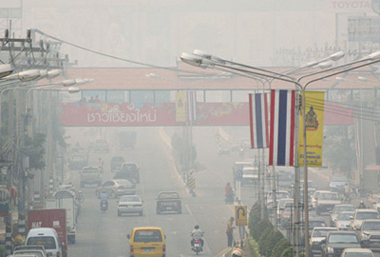Thousands of people in and around Chiang Mai, northern Thailand, have been affected by respiratory infections and other health problems this month, due to the air pollution, which is four times that of the Thai capital, Bangkok.
Another major town, Chiang Rai, was on Tuesday shrouded in a brown haze with air pollution five times worse than the capital, according to the Pollution Control Department.
 |
| Many residents in Chiang Mai, northern Thailand, have been affected by respiratory infections and other health problems this month, due to the air pollution. (Photo: www.hs1ar.com) |
Authorities have recently recommended locals in the tourist-oriented city of Chiang Mai to wear surgical masks if they are cycling or driving motorbikes and advised people not to jog or partake of outdoor exercise or allow children to play in parks.
Health authorities have issued warnings in the local press warning that the current haze could cause heart problems and respiratory diseases, and exacerbate conditions such as asthma and bronchitis. The air pollution could also act as a catalyst for throat and lung cancer, doctors say.
Visibility in the center of Chiang Mai—ironically nicknamed “The Rose of the North” by travel guidebooks—is around 200 meters in the streets. The surrounding mountains—which trap the pollution into the urban valley—cannot be seen from the city. The city’s landmark, Doi Suthep temple, located on a hillside overlooking the city, can be made out faintly at night through the haze, but only when its lights are on.
Staff at
The Irrawaddy, which is located in an office block in the city center, have also been affected. One senior staff member who has worn a surgical mask at work for the past two days, said that when he went to the hospital, he was told hundreds of other people had come in that day with respiratory infections.
“I feel really bad and I can hardly breathe,” he said, adding that he had red irritated eyes, a sore throat, a runny nose and a slight headache.
In the Thai-Burmese border town of Tachilek, a Burmese resident said that she felt sick and that the town was becoming hazier every day. She said that many people in the town had respiratory diseases, especially children and the elderly, and had gone to clinics and hospitals for treatment.
The traditional rural method of slash-and-burn farming, whereby fields are burned by farmers in the dry season between February and April, so that the ashes fertilize the fields while they lie fallow, is responsible for the greater part of the pollution.
According to local government data, the toxic levels of nitrogen dioxide—mainly caused by emissions from factories and motor vehicles—are fairly high in the mountainous northern Thai region. However, the levels of PM-10, a particulate matter of tiny dust particles caused by burning waste, are at a potentially fatal level.
In Europe and the US, the air pollution in an urban area is considered “serious” if PM-10 levels reach 50 micrograms per cubic meter. On Tuesday, PM-10 dust particle levels hit 181.4 in Chiang Mai, 243.7 in Chiang Rai and 236.1 in rural Phayao district.
This year is by no means extraordinary for air pollution in the northern province. In the particularly hazy dry season of 2007, the PM-10 dust particle level in Chiang Mai peaked at a tear-jerking high of 303.9 on March 14, dispelling myths about the northern capital’s reputation as a charming mountain retreat with a healthy ethnic vitality.
According to Earthoria, a travel and lifestyle Web site, even in supposedly “clean” countries such as New Zealand, as many people die every year from air pollution as from traffic accidents.
How has Chiang Mai’s atmosphere been allowed to deteriorate to such polluted levels? We are (literally) dying to find out.

